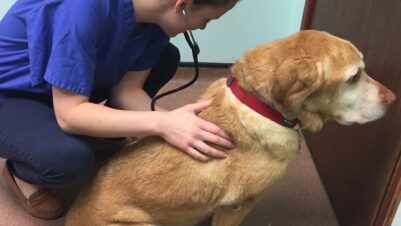THE behaviour study day at
BSAVA congress explored the
causes, medical and mental, of
aggression in dogs, cats and caged
birds. Last month there was a
write-up of the feline section, so
that leaves pugnacious parrots and
cantankerous canines to deal with.
John Chitty was challenged to
present his talk to a mixed audience
of veterinary professionals, students,
behaviourists
and
academics,
many of
whom
had little
experience in
dealing with
medical or
behavioural problems in caged birds.
Fortunately he was able to inform
and entertain in equal measure, despite
our relative ignorance, and we all
gained much from his presentation. He
also took great care to explain normal
ethology and behavioural development
in parrots, and how this can relate
to apparently aberrant behaviour,
especially when behavioural needs are
neither met nor understood.
As with other species, the need
to determine any underlying health
problems was emphasised, in particular
in ruling out pain-related conditions,
e.g. keel trauma due to crash landing,
which could result after wing trimming.
Most of these birds pair for life,
and hand-reared birds are strongly
imprinted on humans, thus will often
perceive a human member of the
opposite sex to be a mate. This can
lead to anxiety and frustration-related
diseases.
Thus, a really thorough history
is vital when investigating cases of
aggression, including how the bird
was reared and what gender it is.
Enlightened breeders will use part
hand-rearing and part parent or
“crèche” rearing to mimic the natural
state and avoid the problems which
result from a brightly lit, sterile and
isolated environment for the chick.
In the wild, chicks develop as a clutch in dark tree cavities or burrows,
with large, infrequent meals, and
explore their rich environment as they
grow.
It is helpful to investigate behaviour
changes in the bird’s normal
environment and to involve as many
family members as possible. Home
videos of normal and abnormal
behaviour could also be used.
As with all species, the fundamental
understanding of the bird’s normal
behaviour and needs is vital, and
the owner must be made aware of dietary, occupational and social
needs, including how to handle and
communicate appropriately with the
bird to avoid misunderstandings and
problem behaviour.
Indestructible, reward-based and
time-consuming toys and puzzle
feeders should be encouraged, whilst
over stimulation and lack of rest (e.g.
birds kept awake all evening by the
TV when they should be sleeping), or
over attachment to one family member
should be discouraged.
Clare Rusbridge gave us an overview
of canine aggression from the
neurological perspective, explaining
how aggression is frequently related to
fear, pain and stress, and is a behaviour associated in the
wild with survival.
Aggression is
rarely caused by
primary brain
disease and is
more likely to
be a secondary
behavioural
response to
brain pathology
such as Chiari
malformation,
inflammatory
brain disease or
during the seizure
postfictal period.
Cognitive
decline, a neurodegenerative condition,
can cause a number of symptoms, of
which aggression may be one. Rabies
would be a classic cause of severe
and acute aggression, accompanied
by other behavioural changes, and
for which veterinary staff must be
constantly vigilant.
Genetic factors
Gary Landsberg then presented an
overview of genetic factors influencing
behaviour, including aggression, and
emphasised that breeds vary greatly
from one country to another, and what
may be generally true of, say, English
Springer Spaniels in the UK, may not be true in the USA. In addition,
the differences between lines within
a breed can be as significant as the
differences between breeds themselves.
Effects of domestication and
selective breeding were explored,
using the silver fox as an example
where tameness became associated
with morphological features. This did
introduce the question as to what may
happen to the temperament of any dog
breed where morphology is selected
over and above temperament.
Gary then turned his attention
to the effects of environment and
human behaviour on development, and
factors which can commonly influence development
of aggression.
Inconsistencies
of handling,
stress, behaviour
of other pets
in the home,
inadequate
socialisation,
maternal factors,
premature
separation
from the dam,
fear evoking
experiences and
punishment are
just some of the
factors which can contribute to development of
aggression in the dog.
A comprehensive history,
observation, video clips, home
assessment, ruling out underlying
medical problems, and diagnosis with
practical treatment programme and
realistic goals should follow.
In aggression cases, risk assessment
and management is of paramount
importance, determining who is at risk
and when. Prognostic factors include
the predictability and severity of the
aggression, family and environment
factors and the owner’s ability to
commit and comply.
An unusual case study was used to
highlight complexities of diagnosis
and the potential use of behaviour
modifying drugs such as SSRIs, TCAs
and anxiolytics.
In addition to our five main speakers,
we welcomed Marta Amat and Hannah
Donovan, giving short presentations
on separation anxiety and consulting
room behaviour of vets and dogs,
respectively.
The audience participated well in the
Q and A sessions, and feedback forms
indicated a high level of satisfaction
with the speakers. Anyone interested
in finding out about BVBA, or joining,
please see www.bvba.org.uk for more
information.






